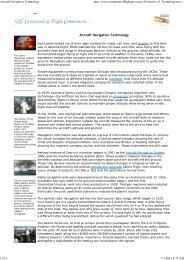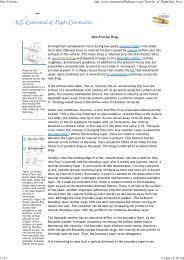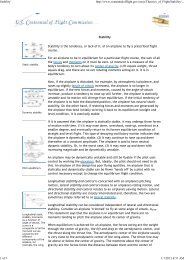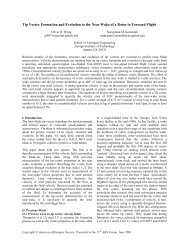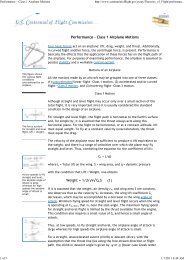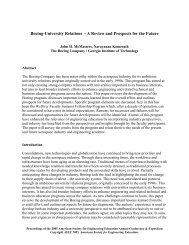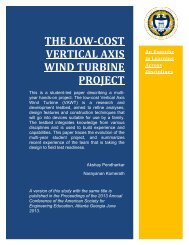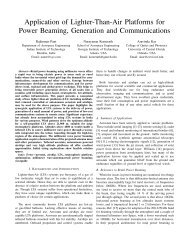Unsteady Aerodynamics of Rotorcraft in Ground Effect - Aerospace ...
Unsteady Aerodynamics of Rotorcraft in Ground Effect - Aerospace ...
Unsteady Aerodynamics of Rotorcraft in Ground Effect - Aerospace ...
Create successful ePaper yourself
Turn your PDF publications into a flip-book with our unique Google optimized e-Paper software.
AIAA Paper 2004-2431, Fluid Dynamics Meet<strong>in</strong>g, Portland, OR, June 2004<br />
<strong>Unsteady</strong> <strong>Aerodynamics</strong> <strong>of</strong> <strong>Rotorcraft</strong> <strong>in</strong> <strong>Ground</strong> <strong>Effect</strong><br />
Balakrishnan Ganesh 1 , Narayanan Komerath 2 .<br />
School <strong>of</strong> <strong>Aerospace</strong> Eng<strong>in</strong>eer<strong>in</strong>g, Georgia Institute <strong>of</strong> Technology, Atlanta, GA 30332-0150<br />
The aerodynamic characteristics <strong>of</strong> rotorcraft flight close to the ground are studied. Flow<br />
visualization was done to identify the flow structure <strong>in</strong> ground effect, and compare it with<br />
the out <strong>of</strong> ground effect flow structure. Hotwire measurements were done to quantify time<br />
scales <strong>of</strong> fluctuations. Six component force measurements were done to measure the loads at<br />
various advance ratios and yaw angles.<br />
µ = Advance Ratio<br />
Nomenclature<br />
I. Introduction<br />
The fundamental fluid dynamics problem here is one where large fluctuations are observed under nom<strong>in</strong>ally<br />
quasi-steady flight conditions, separated by seem<strong>in</strong>gly random <strong>in</strong>tervals. The application <strong>in</strong>terest is described below,<br />
and the approach taken to sort out the different phenomena, are described <strong>in</strong> the rest <strong>of</strong> this extended abstract. This<br />
approach takes us <strong>in</strong>to challenges <strong>in</strong> prediction techniques as well as <strong>in</strong> qualitative and quantitative visualization,<br />
force measurement and other forms <strong>of</strong> uncerta<strong>in</strong>ty reduction.<br />
In ground effect (IGE) conditions, the wake <strong>of</strong> a helicopter rotor <strong>in</strong>teracts with the ground and causes significant<br />
perturbation to the flow near the rotor blades, as well as the rest <strong>of</strong> the craft. Interactions between the ma<strong>in</strong> rotor<br />
wake and the ground have been associated with the formation and passage <strong>of</strong> a ground vortex <strong>in</strong> transitional flight.<br />
These <strong>in</strong>teractions have substantial effects on the handl<strong>in</strong>g qualities, power requirements and stability <strong>of</strong> the craft.<br />
Large transients <strong>in</strong>clud<strong>in</strong>g asymmetric loads and moments have been reported from flight tests <strong>of</strong> new craft.<br />
Differences have also been observed between the performance <strong>of</strong> helicopters hover<strong>in</strong>g close to the ground with<br />
ambient w<strong>in</strong>d and helicopters dur<strong>in</strong>g low speed flight close to the ground.<br />
One <strong>of</strong> the basic questions that arise from the reported flight test results, is whether the unstead<strong>in</strong>ess arises from<br />
the craft <strong>in</strong>teract<strong>in</strong>g with different regions <strong>of</strong> an otherwise quasi-steady flowfield, due to changes <strong>in</strong> w<strong>in</strong>d direction,<br />
ground clearance or aircraft speed – or whether long-period fluctuations are generated <strong>in</strong> an otherwise periodic<br />
flowfield under fixed flight conditions.<br />
Detailed studies <strong>of</strong> the rotor wake and ground vortex was performed with an isolated model rotor above a static<br />
ground plane at low advance ratio, and various ground heights. This study aims to quantify time scales <strong>of</strong><br />
unstead<strong>in</strong>ess by br<strong>in</strong>g<strong>in</strong>g together results from pulsed laser sheet flow visualization, hotwire anemometry, and<br />
fuselage force measurement. In previous work with this experimental set-up, it was shown that the wake was steady<br />
enough <strong>in</strong> the absence <strong>of</strong> ground effect, to enable clear quantification <strong>of</strong> the unstead<strong>in</strong>ess caused by ground effect.<br />
This unstead<strong>in</strong>ess was quantified us<strong>in</strong>g laser sheet imag<strong>in</strong>g <strong>of</strong> vortex dynamics. It was then shown that large<br />
transient velocity fluctuations occurred with long <strong>in</strong>tervals, <strong>in</strong> the ground-vortex and <strong>in</strong> the rotor <strong>in</strong>flow regions.<br />
Subsequent work <strong>in</strong>vestigated whether long-<strong>in</strong>terval transients were also seen <strong>in</strong> the yaw<strong>in</strong>g moments<br />
experienced on generic fuselage models placed <strong>in</strong> the wake <strong>in</strong> ground effect. The present paper <strong>in</strong>vestigates a<br />
decision po<strong>in</strong>t <strong>in</strong> the <strong>in</strong>vestigation <strong>of</strong> unsteady ground effect. It is argued that transients could occur due to two<br />
basically different situations, or a comb<strong>in</strong>ation <strong>of</strong> these situations:<br />
1 PhD Candidate, School <strong>of</strong> <strong>Aerospace</strong> Eng<strong>in</strong>eer<strong>in</strong>g. Student Member, AIAA<br />
2 Pr<strong>of</strong>essor, School <strong>of</strong> <strong>Aerospace</strong> Eng<strong>in</strong>eer<strong>in</strong>g. Associate Fellow, AIAA.<br />
- 1 -<br />
American Institute <strong>of</strong> Aeronautics and Astronautics
a) Due to w<strong>in</strong>d direction and advance ratio change, so that the fuselage/ tail rotor <strong>in</strong>teracts with different parts<br />
<strong>of</strong> the rotor wake. However, the rotor wake for a given flight condition is perfectly periodic. This situation<br />
can be modeled analytically through quasi-steady methods.<br />
b) Even thought the flight condition rema<strong>in</strong>s identical, <strong>in</strong>teractions between vortices, the ground and the<br />
vehicle surfaces, generate transient spikes <strong>in</strong> the forces and moments, with large <strong>in</strong>tervals possible between<br />
such occurrences. This situation is fundamentally unsteady, and requires long-period unsteady simulation<br />
methods with high accuracy.<br />
In real flight tests, these situations may be <strong>in</strong>dist<strong>in</strong>guishable, and may both occur simultaneously. In w<strong>in</strong>d tunnel<br />
tests, the latter situation corresponds to what we had tested so far. The former is the primary subject <strong>of</strong> the tests<br />
conducted, and the data presented <strong>in</strong> this paper.<br />
II. Background<br />
The <strong>in</strong>teraction <strong>of</strong> a rotorcraft wake with the ground dur<strong>in</strong>g low speed flight close to the ground <strong>in</strong>volves two<br />
dist<strong>in</strong>ct flow regimes:<br />
1. Recirculation <strong>of</strong> the wake ahead <strong>of</strong> the rotor at very low advance ratios, caus<strong>in</strong>g additional <strong>in</strong>flow through<br />
the forward part <strong>of</strong> the rotor. 1 (Recirculation Regime)<br />
2. Formation <strong>of</strong> a horseshoe ground vortex under the rotor at higher advance ratios with its associated<br />
<strong>in</strong>teractions. 1 (<strong>Ground</strong> Vortex Regime)<br />
Studies have found irregular changes <strong>in</strong> hub moment for a helicopter fly<strong>in</strong>g close to the ground 2 . Reference 1<br />
noted that the flow fluctuates at a low frequency <strong>in</strong> the recirculation regime. The authors <strong>in</strong> Reference 2 found that<br />
<strong>in</strong> the recirculation flow regime, there is very little lateral flow and moderate level <strong>of</strong> unstead<strong>in</strong>ess <strong>in</strong> the flow field.<br />
The unsteady phenomena have been attributed to the periodic <strong>in</strong>terference fluctuation between downwash and<br />
upwash <strong>in</strong> the recirculation regime 3 .<br />
When rotors are operat<strong>in</strong>g near the ground at low advanced ratios, the forward part <strong>of</strong> rotor wake, after<br />
imp<strong>in</strong>g<strong>in</strong>g on the ground plane, flows forward and then rolls up, form<strong>in</strong>g a recirculation zone around the rotors<br />
(Fig.1). For a s<strong>in</strong>gle rotor, the ground vortex center <strong>in</strong> the longitud<strong>in</strong>al symmetric plane is a little upstream <strong>of</strong> rotor<br />
lead<strong>in</strong>g edge 4 .<br />
Above a critical advance ratio, which depends upon collective pitch and height-to-diameter ratio, a well-def<strong>in</strong>ed<br />
concentrated horseshoe vortex is formed under the rotor, and significant lateral flow is present (Fig.2). The flow<br />
field becomes quite steady. The vortex becomes smaller, and eventually vanished as the advance ratio is <strong>in</strong>creased.<br />
The ground vortex also alters the helicopter yaw control effectiveness <strong>in</strong> sideway and rearward flights near the<br />
ground.<br />
The ground vortex itself is quite unsteady, both <strong>in</strong> size and shape, and also <strong>in</strong> location 5 . The ground vortex has a<br />
large-scale low-frequency pulsat<strong>in</strong>g behavior, which is referred to as puff<strong>in</strong>g <strong>of</strong> the ground vortex. The sequence <strong>of</strong><br />
this puff<strong>in</strong>g behavior is as follows. First the ground vortex is very small, but grow<strong>in</strong>g. For slow forward speed or for<br />
hover <strong>in</strong> light w<strong>in</strong>ds, the ground vortex would stay upstream. As the w<strong>in</strong>d velocity <strong>in</strong>creases, the ground vortex<br />
moves closer to the rotor. Interaction between the old vortices and new vortices <strong>in</strong>creases as forward airspeed<br />
<strong>in</strong>creases. As the ground vortex cont<strong>in</strong>ues to grow, it eventually becomes too large for the flow field to susta<strong>in</strong>. At<br />
this po<strong>in</strong>t the entire flow field breaks up violently, and the large ground vortex is swept downstream. Immediately a<br />
new small ground vortex beg<strong>in</strong>s to grow upstream, and the cyclic process repeats itself 6 .<br />
Tip vortex geometry is changed close to the ground s<strong>in</strong>ce the wake contracts and then expands after imp<strong>in</strong>g<strong>in</strong>g<br />
on the ground, lead<strong>in</strong>g to change <strong>in</strong> radial trajectory <strong>of</strong> the tip vortex when compared to flight away from the<br />
ground 7 . The unstead<strong>in</strong>ess is also more <strong>in</strong> the radial direction.<br />
For a helicopter go<strong>in</strong>g <strong>in</strong>to forward flight, the required power <strong>in</strong>creases <strong>in</strong> the 5~20kt speed regime. The change<br />
<strong>in</strong> <strong>in</strong>flow through the rotor not only affects the required power but the lateral trim as well. Under OGE conditions at<br />
low speed the down flow through the front part <strong>of</strong> the rotor is lower than that through the rear part. This<br />
phenomenon makes the rotor tend to flap with the retreat<strong>in</strong>g side up. The effect <strong>of</strong> the ground vortex is to <strong>in</strong>crease<br />
the down flow through the front part <strong>of</strong> the rotor disc, mak<strong>in</strong>g the flow more uniform and reduc<strong>in</strong>g the requirement<br />
for left stick. After the ground vortex is overrun, left stick is required suddenly 8 .<br />
When a helicopter is <strong>in</strong> rearward or sideward flight, the ground vortex may occur beh<strong>in</strong>d or on the side <strong>of</strong> the<br />
vehicle and may affect the tail rotor. In some helicopter development, the ground vortex causes the loss <strong>of</strong> tail rotor<br />
thrust 9 .<br />
- 2 -<br />
American Institute <strong>of</strong> Aeronautics and Astronautics
III. Experiment description<br />
The experiments were conducted <strong>in</strong> the John J. Harper Low Speed W<strong>in</strong>d Tunnel <strong>of</strong> Georgia Institute <strong>of</strong><br />
Technology. This facility is a closed-circuit w<strong>in</strong>d tunnel with a 7ft × 9ft test section. The rotor and test section is<br />
shown <strong>in</strong> Fig.3. A DC motor is used to drive the rotor shaft at speeds between 0 and 2100 rpm. The specifications <strong>of</strong><br />
the test rotor are shown <strong>in</strong> table 1.<br />
Table 1: Test Rotor Specifications.<br />
Diameter (ft) 3<br />
Chord length (<strong>in</strong>) 3.37<br />
Airfoil<br />
NACA0015<br />
Number <strong>of</strong> blades 2<br />
(Teeter<strong>in</strong>g)<br />
10<br />
(fixed)<br />
Collective<br />
pitch angle(deg)<br />
Twist angle(deg) 0<br />
Rotor shaft tilt angle (deg) 6<br />
Solidity 0.1193<br />
A ground plate was <strong>in</strong>stalled <strong>in</strong> the test section to simulate the ground as shown <strong>in</strong> Fig.4. The flow visualization and<br />
the hot-wire measurements were <strong>in</strong>itially done without the presence <strong>of</strong> a fuselage below the rotor. Laser sheet optics<br />
were placed downstream <strong>of</strong> the test section, and the images were captured by a camera placed perpendicular to the<br />
plane <strong>of</strong> the laser sheet. Flow seed<strong>in</strong>g was generated by fog mach<strong>in</strong>es placed upstream <strong>of</strong> the rotor. Fluctuation<br />
frequencies were studied us<strong>in</strong>g hot-wire probes (TSI 120-120).<br />
A. Test Conditions and Relation to Full-Scale Flight Conditions<br />
Test conditions are shown below. Rotor coord<strong>in</strong>ates are illustrated <strong>in</strong> Fig.5.<br />
• µ = 0.0, 0.03, 0.04, 0.05, 0.06, 0.07,0.08<br />
• Rotor speed: 2100rpm<br />
• IGE (h/D = 0.36) , OGE<br />
• Laser sheet location: y/r = 0, -1/3, -2/3<br />
These conditions are roughly equivalent to those <strong>of</strong> a UH-1B helicopter hover<strong>in</strong>g at a skid altitude <strong>of</strong> 4ft and 0<br />
to 38kt headw<strong>in</strong>d. It should be noted here that the shaft tilt and tip path plane angle are not matched to such flight<br />
conditions. To attempt such match<strong>in</strong>g would be to create needless complications, prevent<strong>in</strong>g systematic exam<strong>in</strong>ation<br />
<strong>of</strong> the basic flow phenomena, and their separation <strong>in</strong>to constituent phenomena.<br />
IV. Results<br />
A. Flow Visualization<br />
The prelim<strong>in</strong>ary results <strong>of</strong> the Flow Visualization done were presented <strong>in</strong> an earlier paper 10 . It was seen that<br />
at low advance ratios between 0.03 and 0.04, the rotor tip vortices move forward and upward, recirculat<strong>in</strong>g through<br />
the rotor disk (Fig.6). 7 or 8 vortices were tracked <strong>in</strong> the loop. The timescale <strong>of</strong> recirculation is approximately<br />
0.11secs (approximately 9Hz) <strong>in</strong> this case<br />
1. Evolution <strong>of</strong> <strong>Ground</strong> Vortex<br />
In order to understand the evolution <strong>of</strong> the ground vortex, flow visualization images with gradually<br />
accelerat<strong>in</strong>g freestream flow (from µ=0.058 to 0.067 <strong>in</strong> 45 secs) were captured. Locations <strong>of</strong> separation po<strong>in</strong>ts for<br />
each µ are summarized <strong>in</strong> Fig.7. At µ=0.056, separation occurred but a ground vortex was not formed yet. At µ-<br />
=0.058, the separated flow rolled and formed a ground vortex. In the range <strong>of</strong> µ=0.060 to 0.067, the ground vortex<br />
moves downstream as the advance ratio <strong>in</strong>creased. It was observed that the separation po<strong>in</strong>t was mov<strong>in</strong>g back and<br />
forth <strong>in</strong>termittently at a fixed advance ratio. As the advance ratio <strong>in</strong>creased, the mean location <strong>of</strong> the separation po<strong>in</strong>t<br />
moved downstream and the amplitude <strong>of</strong> the oscillatory movement became smaller.<br />
2. Flow Visualization (OGE)<br />
Flow visualization out <strong>of</strong> ground effect was done to compare the flow features with flow <strong>in</strong> ground effect.<br />
Recirculation was not observed even at low advance ratio <strong>in</strong> the OGE case. The fluctuation <strong>of</strong> the tip vortex position<br />
was found to be more stable than the IGE case.<br />
- 3 -<br />
American Institute <strong>of</strong> Aeronautics and Astronautics
3. Unstead<strong>in</strong>ess Seen <strong>in</strong> Flow Visualization<br />
In order to compare the unstead<strong>in</strong>ess <strong>of</strong> IGE case and that <strong>of</strong> OGE case, movements <strong>of</strong> tip vortices were<br />
analyzed by look<strong>in</strong>g at the tip vortex location variation at different times captured by us<strong>in</strong>g a video camera. The<br />
results are summarized <strong>in</strong> Table 2. From the table, it can be seen that the IGE case is much more unsteady than the<br />
OGE case. The peak-to-peak jitter for the IGE case is almost double that <strong>of</strong> the OGE case. However, the difference<br />
<strong>in</strong> standard deviation is negligible, imply<strong>in</strong>g that the jitter <strong>in</strong> both cases is similar except for the occasional sharp<br />
change <strong>in</strong> tip vortex position <strong>in</strong> the IGE case.<br />
Table 2: Tip vortex location variation (IGE/OGE, y/r = 0, µ=0.03)<br />
IGE<br />
OGE<br />
x z x z<br />
Max peak to peak variation 0.048r 0.034r 0.032r 0.019r<br />
Standard deviation 0.012r 0.011r 0.011r 0.008r<br />
Measurement uncerta<strong>in</strong>ty 0.010r 0.010r 0.006r 0.006r<br />
x: Horizontal direction<br />
z: Vertical direction<br />
r: Rotor radius<br />
B. Hot-wire Measurement (IGE/OGE)<br />
The most notable result was the difference <strong>in</strong> the fluctuations <strong>in</strong> the <strong>in</strong>flow velocities obta<strong>in</strong>ed from the<br />
hotwire measurements. As was expected, the <strong>in</strong>flow magnitude was lesser for the IGE case. However, the magnitude<br />
<strong>of</strong> fluctuations was negligible <strong>in</strong> the OGE case, while it was about 5 to 10 % <strong>in</strong> the IGE case, and is shown <strong>in</strong> Fig. 8.<br />
The upper and lower bounds are marked <strong>in</strong> red and green respectively, and represent twice the standard deviation.<br />
Also it has to be noted that the IGE case appears to have spikes that seem to re-occur every second. This appears to<br />
be the effect <strong>of</strong> the recirculation <strong>of</strong> the tip vortices.<br />
To get a better idea <strong>of</strong> the frequency <strong>of</strong> these fluctuations, a Fourier analysis was done to the velocity time<br />
trace. The results are shown <strong>in</strong> Fig. 9. It can be seen that the 2 per rev component dom<strong>in</strong>ates the flow out <strong>of</strong> ground<br />
effect. However, with the ground plane, the spectrum is dom<strong>in</strong>ated by low frequency components. It can be seen that<br />
there is a dist<strong>in</strong>ct difference between the low frequency components <strong>in</strong> the IGE and the OGE case. In fact, the peak<br />
frequency <strong>in</strong> the IGE case occurs at about 1 Hz, even overshadow<strong>in</strong>g the 2 per rev spike, which is dom<strong>in</strong>ant <strong>in</strong> the<br />
OGE case. This difference can be seen <strong>in</strong> Fig.9, which shows the Fourier coefficients for the two cases at advance<br />
ratios <strong>of</strong> 0.03, 0.04 and 0.05.<br />
The results <strong>of</strong> the hotwire measurements close to the ground vortex are plotted <strong>in</strong> Fig. 10. It can be seen<br />
that at po<strong>in</strong>t A, a velocity fluctuation at low frequency (1 to 2 Hz) occurs and appears to be related to the movement<br />
<strong>of</strong> the flow separation po<strong>in</strong>t ahead <strong>of</strong> the nascent ground vortex. This correlates with the flow visualization results at<br />
an advance ratio <strong>of</strong> 0.05 where the flow appeared to switch between recirculation and the prelim<strong>in</strong>ary stage <strong>of</strong><br />
formation <strong>of</strong> a ground vortex. At both po<strong>in</strong>ts C and E, the frequency <strong>of</strong> the velocity fluctuation became relatively<br />
broad-band (between 0 and 50Hz). The mean flow velocities at these po<strong>in</strong>ts were higher than free stream speed,<br />
which is approximately 16.5fps at an advance ratio <strong>of</strong> 0.05. At po<strong>in</strong>t G, a low frequency velocity fluctuation occurs.<br />
However, it is not similar to the large velocity separation-like change that occurs at po<strong>in</strong>t A, and appears to be<br />
<strong>in</strong>duced by the passage <strong>of</strong> the tip vortex.<br />
The isolated-rotor experiments above served to establish that<br />
1. we could <strong>in</strong>deed achieve clean periodic flow conditions <strong>in</strong> the absence <strong>of</strong> ground effect<br />
2. that the rise <strong>in</strong> unstead<strong>in</strong>ess due to ground effect was clearly perceptible and quantifiable<br />
3. that wake <strong>in</strong>teraction with the ground does cause unstead<strong>in</strong>ess <strong>in</strong> the ground vortex.<br />
4. that recirculation <strong>of</strong> vortices does cause fluctuations <strong>in</strong> the rotor <strong>in</strong>flow plane.<br />
5. long-period unstead<strong>in</strong>ess is <strong>in</strong>deed seen <strong>in</strong> the flowfield<br />
The new work for this paper focused on observations with a fuselage present <strong>in</strong> the flowfield. This is essential<br />
to (eventually) relate flowfield observations with pilot experience <strong>of</strong> stick forces and moments. These measurements<br />
would help <strong>in</strong> quantify<strong>in</strong>g the fuselage loads decoupled from the rotor hub moments.<br />
C. Fuselage Side Force Measurements<br />
- 4 -<br />
American Institute <strong>of</strong> Aeronautics and Astronautics
1. Experiment Setup<br />
The fuselage was mounted through a hole <strong>in</strong> the ground plane, and was set up to yaw about an axis that was<br />
perpendicular to the ground. The experimental setup is shown <strong>in</strong> Fig.11. The fuselage is a fiberglass cyl<strong>in</strong>der 34”<br />
long, with a hemispherical nose with a radius <strong>of</strong> 5.5”. A picture <strong>of</strong> the setup is shown <strong>in</strong> Fig.12. The directional<br />
convention <strong>of</strong> the forces measured are shown <strong>in</strong> Fig.13.<br />
2. Experimental Results<br />
The side force on the fuselage was first measured with the yaw angle fixed at 0°. Analogous to the hotwire<br />
experiments, there is a significant low frequency component <strong>in</strong> the IGE case at low advance ratios that reduces with<br />
advance ratio <strong>in</strong>crease. This trend can be seen <strong>in</strong> Fig.14. The Fourier components <strong>of</strong> side force at advance ratios <strong>of</strong><br />
0.03 and 0.08 are plotted for the IGE and OGE cases. Out <strong>of</strong> ground effect, the 1 and 2 per rev components<br />
dom<strong>in</strong>ates the spectrum. In ground effect, however, there seems to considerable low frequency components <strong>in</strong> the<br />
side force. A similar trend was seen <strong>in</strong> all the forces measured. At an advance ratio <strong>of</strong> 0.03 <strong>in</strong> ground effect, the two<br />
ma<strong>in</strong> frequencies are 7 Hz and 14 Hz. At an advance ratio <strong>of</strong> 0.08 <strong>in</strong> ground effect, the 7 Hz component has almost<br />
completely disappeared, and is dom<strong>in</strong>ated by the 14 Hz component. The response <strong>of</strong> the force balance to a step<br />
disturbance was <strong>in</strong>vestigated to understand these frequency components. This is plotted <strong>in</strong> Fig.15, and shows that the<br />
natural frequency <strong>of</strong> the balance is at 7 and 14 Hz. Therefore; we can conclude that <strong>in</strong> ground effect the natural<br />
frequency vibration <strong>of</strong> the fuselage is <strong>of</strong> the same order <strong>of</strong> magnitude <strong>of</strong> the 1 and 2 per rev components. Outside<br />
ground effect, however, the 1 and 2 per rev components are much bigger than the natural frequency vibration <strong>of</strong> the<br />
balance. Also, the low frequency fluctuations seen <strong>in</strong> hotwire measurements are not discernible <strong>in</strong> the fuselage force<br />
measurements. This is to be expected, because the hotwire fluctuations seen <strong>in</strong> the <strong>in</strong>flow and ground vortex are<br />
localized fluctuations and their effects tend to be smoothed out when <strong>in</strong>tegrated over the entire fuselage. A more<br />
detailed analysis <strong>of</strong> the Fourier coefficients <strong>of</strong> the side force <strong>in</strong> ground effect at various advance ratios is shown <strong>in</strong><br />
Fig.16. All <strong>of</strong> them are plotted to the same scale. It can be seen that it is the 7 Hz component reduces <strong>in</strong> value with<br />
<strong>in</strong>creas<strong>in</strong>g advance ratio, <strong>in</strong>dicat<strong>in</strong>g that the lower frequency excitation <strong>of</strong> the balance reduces with advance ratio.<br />
But it can be seen that there is no clear 1 Hz component as was seen <strong>in</strong> the hotwire measurements. This <strong>in</strong>dicates<br />
that the unstead<strong>in</strong>ess seen <strong>in</strong> ground effect can be tackled on two fronts.<br />
a) Long time scale fluctuations seen <strong>in</strong> the <strong>in</strong>flow and around the ground vortex, lead<strong>in</strong>g to thrust and<br />
power variation. This would imply that unstead<strong>in</strong>ess exists even <strong>in</strong> a trimmed condition <strong>in</strong> ground<br />
effect at low advance ratios.<br />
b) Change <strong>in</strong> the forces felt on the fuselage due to the wake structure <strong>in</strong> ground effect. The rotorcraft<br />
would handle quite differently when compared to its handl<strong>in</strong>g out <strong>of</strong> ground effect at the same regime<br />
<strong>of</strong> flight. However, this change is a quasi-steady variation that can be trimmed <strong>of</strong>f, if the changes are<br />
anticipated.<br />
Another <strong>in</strong>terest<strong>in</strong>g phenomenon that was noticed is a change <strong>in</strong> side force from positive to negative at an<br />
advance ratio <strong>of</strong> about 0.06. This is shown <strong>in</strong> Fig.17. Interest<strong>in</strong>gly, this change <strong>in</strong> the direction <strong>of</strong> the side force<br />
occurs at the advance ratio when there is a change from the recirculation regime result<strong>in</strong>g <strong>in</strong> the formation <strong>of</strong> the<br />
ground vortex. Furthermore, this change is associated with a change <strong>in</strong> slope <strong>of</strong> the curve, with a dist<strong>in</strong>ct k<strong>in</strong>k at the<br />
zero side force advance ratio. The sideward center <strong>of</strong> pressure, where the side force acts on the fuselage is also<br />
plotted <strong>in</strong> Fig.17. These values were obta<strong>in</strong>ed by divid<strong>in</strong>g the yaw<strong>in</strong>g moment by the side force, with the zero value<br />
be<strong>in</strong>g the center <strong>of</strong> the load cell as shown <strong>in</strong> Fig.11. It can be seen that the change <strong>in</strong> the direction <strong>of</strong> the side force is<br />
accompanied by a rearward shift <strong>of</strong> the side force moment arm. It can also be seen that after that the IGE values start<br />
tend<strong>in</strong>g towards the OGE values, <strong>in</strong>dicat<strong>in</strong>g that the ground vortex has now been swept beh<strong>in</strong>d the fuselage, and its<br />
effect on the fuselage is now negligible. This is an <strong>in</strong>dicator that it is at this advance ratio that the wake <strong>in</strong>teracts<br />
with the tail rotor caus<strong>in</strong>g a sudden change <strong>in</strong> tail rotor effectiveness as measured <strong>in</strong> Ref.9.<br />
An <strong>in</strong>vestigation <strong>in</strong>to the variation <strong>of</strong> side-force at various yaw angles was carried out. It can be seen from<br />
Fig.18 that the yaw angle for zero side force changes with advance ratios. The vertical dotted black l<strong>in</strong>e represents<br />
zero degrees yaw, and the horizontal dotted black l<strong>in</strong>e represents zero side force. To visualize the same phenomena<br />
mentioned <strong>in</strong> the previous paragraph, one has to start at the po<strong>in</strong>t <strong>of</strong> <strong>in</strong>tersection <strong>of</strong> the hover l<strong>in</strong>e and the vertical<br />
zero degree yaw l<strong>in</strong>e, and move downward with advance ratio along the zero degree yaw l<strong>in</strong>e. It can be seen that<br />
there is a switch <strong>in</strong> the direction <strong>of</strong> the side force at an advance ratio <strong>of</strong> about 0.05. This seems to suggest that it is a<br />
function <strong>of</strong> the flow <strong>in</strong>teraction rather than the effect <strong>of</strong> a flaw <strong>in</strong> cyl<strong>in</strong>der shape. Similarly, if one were to move to<br />
the right along the zero sideforce l<strong>in</strong>e, it is seen that the zero side force at higher advance ratios occurs at higher<br />
positive yaw angles. A similar result was obta<strong>in</strong>ed when the sideforce is measured with the fuselage be<strong>in</strong>g yawed<br />
dynamically at 3 RPM. The side force results out <strong>of</strong> ground effect can be seen <strong>in</strong> Fig.19. Several <strong>in</strong>terest<strong>in</strong>g<br />
differences can be seen between the results <strong>of</strong> Figs.18 and 19.<br />
- 5 -<br />
American Institute <strong>of</strong> Aeronautics and Astronautics
a) The force vs. yaw angle plot out <strong>of</strong> ground effect is symmetric about the zero degree yaw angle l<strong>in</strong>e. It<br />
can be seen from Fig.19 that at zero degree yaw, the side force changes to a negative value as soon as<br />
the regime <strong>of</strong> flight changes from hover to forward flight, and thereafter stays fairly constant with<br />
<strong>in</strong>creas<strong>in</strong>g advance ratio. In ground effect, however, it can be seen from Fig.18 that the side force<br />
variation is gradual and progressive at zero degree yaw with <strong>in</strong>creas<strong>in</strong>g advance ratio. This can be seen<br />
by mov<strong>in</strong>g down the vertical dotted black l<strong>in</strong>e <strong>in</strong> Figs. 18 and 19, and the result<strong>in</strong>g data would be the<br />
plot <strong>in</strong> Fig.17.<br />
b) The magnitude <strong>of</strong> the side force at higher yaw angles out <strong>of</strong> ground effect is more than the magnitude<br />
<strong>in</strong> ground effect.<br />
c) An <strong>in</strong>terest<strong>in</strong>g phenomenon observed <strong>in</strong> ground effect is shown marked <strong>in</strong> the red dotted box <strong>in</strong> Fig.18.<br />
At advance ratios above 0.06, there is a sudden <strong>in</strong>crease <strong>in</strong> the side force at yaw angles between 20°<br />
and 60°. This appears to be a lift production phenomenon with a sudden <strong>in</strong>crease <strong>in</strong> side force followed<br />
by a stall. This conclusion is buttressed by plott<strong>in</strong>g the center <strong>of</strong> pressure <strong>of</strong> the side force <strong>in</strong> Fig.20.<br />
These values were obta<strong>in</strong>ed by divid<strong>in</strong>g the yaw<strong>in</strong>g moment by the side force, as expla<strong>in</strong>ed <strong>in</strong> the<br />
previous paragraph. It can be seen there is a forward moment <strong>of</strong> the yaw<strong>in</strong>g moment arm at the same<br />
advance ratio-yaw angle comb<strong>in</strong>ation, which supports the conclusion <strong>of</strong> the observed phenomenon<br />
be<strong>in</strong>g a lift production phenomenon. This can be correlated with <strong>in</strong>puts obta<strong>in</strong>ed from various<br />
helicopter operators <strong>in</strong> the <strong>in</strong>dustry, who note that there is a considerable difference <strong>in</strong> the side forces<br />
produced <strong>in</strong> ground effect by fuselages <strong>of</strong> various cross sections. We can anticipate that this force<br />
would be higher <strong>in</strong> a sideward-contoured fuselage, like the hemisphere nose cyl<strong>in</strong>drical fuselage used<br />
<strong>in</strong> this experiment. Experiments on a sideward-flattened fuselage will be carried out to test this<br />
hypothesis.<br />
The comparison <strong>of</strong> the fuselage lift <strong>in</strong> and out <strong>of</strong> ground effect is seen <strong>in</strong> Fig.21. It can be seen that there is<br />
a considerable reduction <strong>in</strong> the fuselage lift produced <strong>in</strong> ground effect, and this is due to the change <strong>in</strong> the<br />
wake structure due to the presence <strong>of</strong> the ground. The presence <strong>of</strong> the ground cuts <strong>of</strong> the spiral wake<br />
structure, and this coupled with the mirror image vorticity causes a reduction <strong>in</strong> the upward force on the<br />
fuselage.<br />
V. Conclusions<br />
1. Flow Visualization <strong>of</strong> a rotor <strong>in</strong> ground effect was able to capture two regimes <strong>of</strong> flight, with a recirculat<strong>in</strong>g<br />
flow pattern at an advance ratio less than 0.05, and a ground vortex regime between advance ratios <strong>of</strong> 0.05 to<br />
0.08. Tip vortices were tracked, and it was found that the time scale <strong>of</strong> recirculation was about 0.11 seconds.<br />
2. This was correlated with the blips seen <strong>in</strong> the hotwire measurements <strong>in</strong> ground effect, which seem to be<br />
dependent on the recirculated vortex passage.<br />
3. A peak frequency component <strong>of</strong> 1 Hz was seen <strong>in</strong> the IGE hotwire data – with the fundamental blade passage<br />
frequency be<strong>in</strong>g 35Hz.<br />
4. These are presumably accessible by quasi-steady-state prediction methods. Prelim<strong>in</strong>ary results from the<br />
fuselage side force measurements <strong>in</strong>dicate that there is a switch <strong>in</strong> the direction <strong>of</strong> the sideforce as the helicopter<br />
accelerates <strong>in</strong> ground effect, and this switch seems to occur at the advance ratio where the ground vortex<br />
formation occurs.<br />
5. The follow<strong>in</strong>g flow phenomena <strong>in</strong> helicopter flight close to ground that have been identified.<br />
• Inherent unstead<strong>in</strong>ess <strong>in</strong> the flow pattern due to a rotor <strong>in</strong> ground<br />
effect without a fuselage, which has been <strong>in</strong>vestigated and found <strong>in</strong> flow visualization and hotwire<br />
anemometry. This situation is fundamentally unsteady, and requires long-period unsteady simulation methods<br />
with high accuracy. These long time scales pose a major challenge for numerical predictions, but appear to be<br />
due to vortex <strong>in</strong>teractions which can be modeled by <strong>in</strong>viscid methods.<br />
• Unstead<strong>in</strong>ess IGE due to <strong>in</strong>teraction <strong>of</strong> the<br />
wake with the fuselage and ground- compris<strong>in</strong>g <strong>of</strong> two subdivisions.<br />
a) The w<strong>in</strong>d direction and advance ratio change, so that the fuselage/ tail<br />
rotor <strong>in</strong>teract with different parts <strong>of</strong> the rotor wake. However, the rotor<br />
wake for a given flight condition is perfectly periodic. This situation<br />
can be modeled analytically through quasi-steady methods.<br />
b) Even thought the flight condition rema<strong>in</strong>s identical, <strong>in</strong>teractions<br />
between vortices, the ground and the vehicle surfaces, generate transient spikes <strong>in</strong> the forces and<br />
- 6 -<br />
American Institute <strong>of</strong> Aeronautics and Astronautics
moments, with large <strong>in</strong>tervals possible between such occurrences. This situation is fundamentally<br />
unsteady, and requires long-period unsteady simulation methods with high accuracy.<br />
• Control changes due to <strong>in</strong>gestion <strong>of</strong> the ma<strong>in</strong> rotor wake <strong>in</strong>to<br />
the tail rotor caus<strong>in</strong>g loss <strong>in</strong> tail rotor thrust, as studied <strong>in</strong> Ref.9.<br />
• A sudden <strong>in</strong>crease at positive yaw angles that seems to be dependent on fuselage cross section.<br />
• Considerable reduction <strong>in</strong> the fuselage lift <strong>in</strong> ground effect, due to change <strong>in</strong> wake structure.<br />
Experimental Uncerta<strong>in</strong>ty<br />
One <strong>of</strong> the major achievements <strong>in</strong> this experiment is that the flow <strong>in</strong> the OGE case has been<br />
captured with so little uncerta<strong>in</strong>ty that the IGE fluctuations can be properly quantified. This<br />
issue is exam<strong>in</strong>ed us<strong>in</strong>g flow visualization, hot-wire measurements, and now us<strong>in</strong>g stra<strong>in</strong>gage /<br />
load cell measurements <strong>of</strong> fuselage loads.<br />
1) Flow Visualization: Error <strong>in</strong> quantify<strong>in</strong>g ground vortex position with respect to advance ratio<br />
is exam<strong>in</strong>ed below. The position was plotted by digitiz<strong>in</strong>g video images, and mark<strong>in</strong>g the edge <strong>of</strong><br />
the void area that was formed due to lack <strong>of</strong> seed particles <strong>in</strong> the vortex. The coverage area <strong>of</strong><br />
the image was 60 <strong>in</strong>ches by 25 <strong>in</strong>ches. The image was digitized <strong>in</strong>to a 1280 by 768 pixels bitmap.<br />
S<strong>in</strong>ce the edge <strong>of</strong> the void area cannot be resolved under one pixel, the error probability <strong>of</strong> the<br />
position is approximately 0.04 <strong>in</strong>. The result<strong>in</strong>g uncerta<strong>in</strong>ty is exam<strong>in</strong>ed <strong>in</strong> Table 2.<br />
2) Hotwire Measurements: The ma<strong>in</strong> reason for errors <strong>in</strong> Hotwire measurements is the wire<br />
orientation <strong>of</strong> the Hotwire, after the calibration has been done and checked with test runs 11 .<br />
Alignment for this experiment was checked with a laser alignment tool, with a beam diameter <strong>of</strong><br />
0.1 <strong>in</strong>. This beam was aligned with a mark on the wall, 4.5 ft away. Assum<strong>in</strong>g the worst-case<br />
error was one diameter <strong>of</strong> the laser beam, this works out to a maximum error <strong>of</strong> 0.1°.<br />
3) Force Measurements: The force balance was calibrated with precision weights, and the<br />
response was found to be l<strong>in</strong>ear. Five sets <strong>of</strong> check runs were done with precision weights, both<br />
<strong>in</strong> the negative and positive side force direction. The error was found to be less than 1% for the<br />
side force. The 6 d.o.f load cell be<strong>in</strong>g used has an error less than 0.5% <strong>of</strong> full load.<br />
References<br />
1 Curtiss, H.C. Jr., Sun, M., Putman, W.F., Hanker, E.J. Jr., “ Rotor <strong>Aerodynamics</strong> <strong>in</strong> <strong>Ground</strong> <strong>Effect</strong> at Low<br />
Advance Ratios”, Journal AHS, Jan. 1984.<br />
2 Curtiss Jr., H.C., Erdman, W., and Sun, M., “<strong>Ground</strong> <strong>Effect</strong> <strong>Aerodynamics</strong>”, International Conference on<br />
<strong>Rotorcraft</strong> Basic Research, 1985.<br />
3 X<strong>in</strong>, H., “Development and Validation <strong>of</strong> a Generalized <strong>Ground</strong> <strong>Effect</strong> Model for Lift<strong>in</strong>g Rotors”, PhD Thesis,<br />
Georgia Tech, 1999.<br />
4 Hanker, E.J. Jr. and Smith, R.P., “Parameters Affect<strong>in</strong>g Helicopter Interactional <strong>Aerodynamics</strong> <strong>in</strong> <strong>Ground</strong> <strong>Effect</strong>”,<br />
Journal AHS, Jan 1985.<br />
5 Cimbala, J.M., Billet, M.L., Gaublomme, D.P., and Oefele<strong>in</strong>, “Experiments on the Unstead<strong>in</strong>ess Associated with a<br />
<strong>Ground</strong> Vortex”, Journal <strong>of</strong> Aircraft, Apr. 1991.<br />
- 7 -<br />
American Institute <strong>of</strong> Aeronautics and Astronautics
6 Saberi, H.A. and Maisel, M.D., “A Free-Wake Rotor Analysis Includ<strong>in</strong>g <strong>Ground</strong> <strong>Effect</strong>”, Annual Forum<br />
Proceed<strong>in</strong>gs, 43rd American Helicopter Society.<br />
7 Light, J.S., “Tip Vortex Geometry <strong>of</strong> a Hover<strong>in</strong>g Helicopter Rotor <strong>in</strong> <strong>Ground</strong> <strong>Effect</strong>”, Journal <strong>of</strong> the American<br />
Helicopter Society, Apr 1993.<br />
8 Prouty, R.W., “Operations Flight <strong>in</strong> Turbulent Air”, Article <strong>of</strong> “NASA Civil Helicopter Safety Web Site”, Aug.<br />
2001.<br />
9 Empey, R.W., and Ormiston, R.A., “Tail Rotor Thrust on a 5.5 Foot Helicopter Model <strong>in</strong> <strong>Ground</strong> <strong>Effect</strong>”, 30 th<br />
Annual Forum <strong>of</strong> AHS, May 1974.<br />
10 Saijo, T., et al., “Development <strong>of</strong> Unstead<strong>in</strong>ess <strong>in</strong> the Wake <strong>of</strong> a Rotor n <strong>Ground</strong> <strong>Effect</strong>”, 59 th Annual Forum <strong>of</strong><br />
AHS, 2003.<br />
11 Yosh<strong>in</strong>o, F et al., “Hot-wire Direction Error Response Equations <strong>in</strong> Two-Dimensional Flows”., J <strong>of</strong> Phy. E:Sci.<br />
Instrum., 1989, Vol.22., pp 480-490.<br />
V ∝<br />
Figure 1: Schematic <strong>of</strong> Recirculation zone<br />
<strong>Ground</strong> Vortex<br />
V ∝<br />
- 8 -<br />
American Institute <strong>of</strong> Aeronautics and Astronautics<br />
Figure 2: Schematic <strong>of</strong> <strong>Ground</strong> Vortex
Figure 3: Rotor and Test Section<br />
Figure 4: Rotor with <strong>Ground</strong> Plane. - 9 -<br />
American Institute <strong>of</strong> Aeronautics and Astronautics
Figure 5: Coord<strong>in</strong>ate System <strong>of</strong> the Rotor.<br />
Figure 6: Recirculation (IGE, y/r = 0, µ=0.03)<br />
- 10 -<br />
American Institute <strong>of</strong> Aeronautics and Astronautics<br />
Note: Inflow fluctuations IGE ~ 5-10%
x 10 6 Hotwire IGE Adv 0.03 Peak freq =70.0<br />
6<br />
12 x 106 Hotwire IGE Adv 0.04. Peak freq =1.7<br />
Fourier Power Spectral Density<br />
5<br />
4<br />
3<br />
2<br />
1<br />
Fourier Power Spectral Density<br />
10<br />
8<br />
6<br />
4<br />
2<br />
0<br />
0 10 20 30 40 50 60 70 80<br />
Frequency<br />
0<br />
0 10 20 30 40 50 60 70 80<br />
Frequency<br />
Fourier Power Spectral Density<br />
x 10 6<br />
9<br />
8<br />
7<br />
6<br />
5<br />
4<br />
3<br />
2<br />
Hotwire- IGE Adv 0.05. Peak freq= 1.1<br />
Fourier Power Spectral Density<br />
x 10 4 Hotwire OGE Adv 0.03 Peak freq =70.0<br />
4<br />
3.5<br />
3<br />
2.5<br />
2<br />
1.5<br />
1<br />
1<br />
0.5<br />
0<br />
0 10 20 30 40 50 60 70 80<br />
Frequency<br />
0<br />
0 10 20 30 40 50 60 70 80<br />
Frequency<br />
4<br />
x 10 4 Hotwire OGE Adv 0.04 Peak freq =70.0<br />
x 10 4 Hotwire OGE Adv 0.05 Maxfreq 70.0<br />
6<br />
Fourier Power Spectral Density<br />
3.5<br />
3<br />
2.5<br />
2<br />
1.5<br />
1<br />
0.5<br />
Fourier Power Spectral Density<br />
5<br />
4<br />
3<br />
2<br />
1<br />
0<br />
0 10 20 30 40 50 60 70 80<br />
Frequency<br />
0<br />
0 10 20 30 40 50 60 70 80<br />
Frequency<br />
Figure 9: Comparison <strong>of</strong> Hotwire Frequencies. IGE vs OGE. Advance Ratios 0.03, 0.04, and 0.05<br />
- 11 -<br />
American Institute <strong>of</strong> Aeronautics and Astronautics
(a)<br />
(e)<br />
Velocity(fps)<br />
Velocity(fps)<br />
100<br />
80<br />
60<br />
40<br />
20<br />
100<br />
0<br />
0 2 4 6 8 10<br />
Time(sec)<br />
80<br />
60<br />
40<br />
20<br />
a c e g h<br />
0<br />
0 2 4 6 8 10<br />
Time(sec)<br />
Velocity(fps)<br />
Velocity(fps)<br />
100<br />
80<br />
60<br />
40<br />
20<br />
0<br />
0 2 4 6 8 10<br />
Time(sec)<br />
100<br />
80<br />
60<br />
40<br />
20<br />
0<br />
0 2 4 6 8 10<br />
Time(sec)<br />
(c)<br />
(g)<br />
(h)<br />
Velocity(fps)<br />
100<br />
80<br />
60<br />
40<br />
20<br />
0<br />
0 2 4 6<br />
Time(sec)<br />
8 10<br />
Figure 10: <strong>Ground</strong> Vortex Velocity Measurements<br />
Advance Ratio 0.05<br />
Rotor Shaft Axis<br />
Rotor Radius ‘r’<br />
18”<br />
0.4 r<br />
<strong>Ground</strong> Normal<br />
0.72 r<br />
0.5 r<br />
1.9 r<br />
Simulated<br />
<strong>Ground</strong> Plane<br />
- 12 -<br />
American Institute <strong>of</strong> Aeronautics and Astronautics<br />
Load Cells<br />
Stepper Motor<br />
Tunnel Floor
Figure 12: Experimental Setup: Fuselage Force Measurement<br />
Direction <strong>of</strong><br />
rotor rotation<br />
- 13 -<br />
American Institute <strong>of</strong> Aeronautics and Astronautics<br />
Figure 13: Directional Convention <strong>of</strong> Forces and Moments
Figure 14: Difference <strong>in</strong> Low Frequency Components <strong>of</strong> Side Force at Advance Ratios 0.03 and 0.08<br />
- 14 -<br />
American Institute <strong>of</strong> Aeronautics and Astronautics<br />
Figure 15: Natural Frequency <strong>of</strong> Load Cell Side Force to a step disturbance.
Figure 17: Variation <strong>of</strong> Side Force and Sideward Center <strong>of</strong> Pressure with Advance Ratio IGE vs. OGE, 0° Yaw.<br />
Figure 16: Variation <strong>of</strong> Frequency Components with <strong>in</strong>creas<strong>in</strong>g Advance Ratios IGE.<br />
- 15 -<br />
American Institute <strong>of</strong> Aeronautics and Astronautics
Figure 18: Variation <strong>of</strong> Side Force <strong>in</strong> <strong>Ground</strong> <strong>Effect</strong> with Yaw Angle at Various Advance Ratios<br />
- 16 -<br />
American Institute <strong>of</strong> Aeronautics and Astronautics<br />
Figure 19: Variation <strong>of</strong> Side Force out <strong>of</strong> <strong>Ground</strong> <strong>Effect</strong> with Yaw Angle at<br />
Various Advance Ratios
Figure 20: Variation <strong>of</strong> Side Force Center <strong>of</strong> Pressure <strong>in</strong> <strong>Ground</strong> <strong>Effect</strong> with Yaw<br />
Angle at Various Advance Ratios<br />
- 17 -<br />
American Institute <strong>of</strong> Aeronautics and Astronautics<br />
Figure 21: Comparison <strong>of</strong> Fuselage lift IGE vs. OGE
- 18 -<br />
American Institute <strong>of</strong> Aeronautics and Astronautics


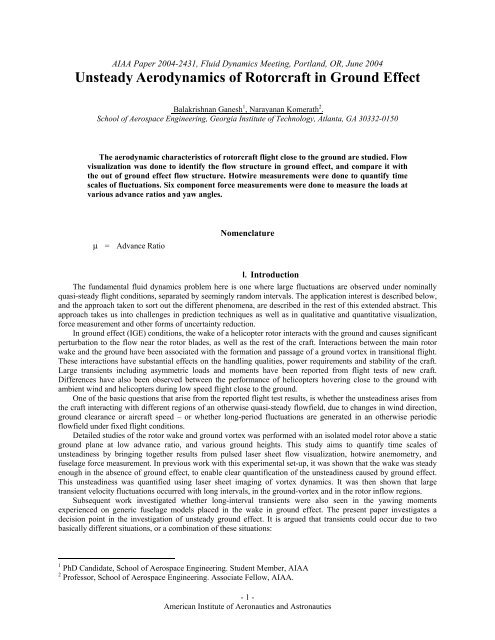
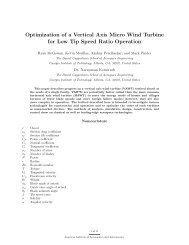
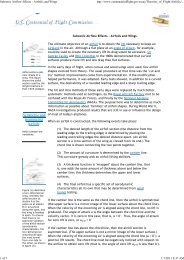

![p density of fluid, kg/m3 [Greek letter rho] V mean velocity of fluid, m ...](https://img.yumpu.com/50595898/1/184x260/p-density-of-fluid-kg-m3-greek-letter-rho-v-mean-velocity-of-fluid-m-.jpg?quality=85)
